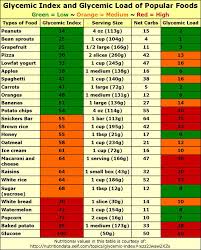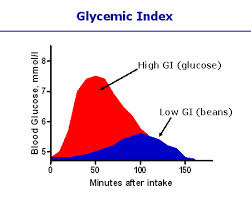Low Glycemic Index Foods

I like to talk about low glycemic index foods. There are many misconception on what it is and what it does to your body.
Click below and see how GI foods affects your body.
The TRUTH about Potatoes, Glycemic Index, and "White Foods" - Friend or Foe for Fat Loss?
by Mike Geary, Certified Nutrition Specialist, Certified Personal Trainer
Author of best-sellers: The Fat Burning Kitchen & The Top 101 Foods that FIGHT Aging
Low Glycemic Index Foods – GI
Glycemic index is a measure of the carbohydrates in a food that affects blood glucose level. If you eat carbohydrates with a low GI, you will get a more even blood sugar and thus keep you full longer.
Are you training at least every other day so you automatically get a lower GI of what you eat.
The glycemic index is a measure of how fast and long as the blood sugar level is affected by different foods. The absorption of carbohydrates is slow, it leads to a more even blood sugar level.
The Carbohydrates that are absorbed slowly by the body are called simplex carbohydrates and will have low glycemic index foods.
Carbohydrates with a high glycemic index (simple carbohydrates), are taken up quickly by the body.
Difference between fast and slow carbs
Fast carbohydrates - get hungry quickly
Graph of how fast and slow carbohydrates affect blood sugar.

If you eat simple carbs (carbohydrates with a high glycemic index)
carbohydrates are quickly absorbed by the body. This increases the
glucose level quickly (sugar in the blood).
When the glucose
concentration increases, the body must turn on their insulin. Insulin
lowers blood glucose by increasing the cellular uptake of glucose and
take in the sugar into the cells and store it there.
A great
supplement of insulin causes the blood sugar pretty quickly drops to a
low level, and you will then be hungry or hungry again.
The TRUTH about Potatoes, Glycemic Index, and "White Foods" - Friend or Foe for Fat Loss?
The glucose that has already been taken into the cells will become fat.
Slow carbohydrates - full longer
If you eat complex carbohydrates will glucose level to rise slowly.
The
insulin will not turn on at the same speed and amount, and you will
maintain your blood sugar at a steady level for a long time. You will
also feel fuller.
If you push the lemon over the food, lower the entire meal GI.
Low-Glycemic-Index-Foods:
Whole wheat bread (but higher GI of the bread is finely ground)
Juice (acids lowers the GI of the meal)
Chick peas, soybeans, green vegetables, walnuts, beans, etc.
See full list of the different food glycemic index HERE.
As will be calculated GI
GI value is calculated based on the 50 grams of carbohydrates in food affect blood sugar levels two hours after you've eaten it.
As a reference you use white bread that has GI 100th
High GI need not be bad
Low Glycemic index Foods only takes into account how carbohydrates affect blood sugar and not about how big a normal portion is.
Potatoes are good despite the high GI
For
example, the potato a higher glycemic index than pasta. But you do not
eat as much potatoes as you need to eat pasta to achieve saturation.
Therefore,
the portion of potatoes less carbohydrate than serving pasta. The total
amount of carbohydrates will be less, and achieve a smaller increase in
blood sugar if you eat potatoes, although the potato has a higher GI.
Low-Glycemic-Index-Foods
Glycemic load (GL)
It
is a measure, glycemic load (GL), which gives a fairer view of how
foods affect blood sugar. As opposed to the glycemic index (GI) takes
into account how much you eat of each food.
The TRUTH about Potatoes, Glycemic Index, and "White Foods" - Friend or Foe for Fat Loss?
Low Glycemic Index Foods to Homepage
Stevia - The Better Alternative
